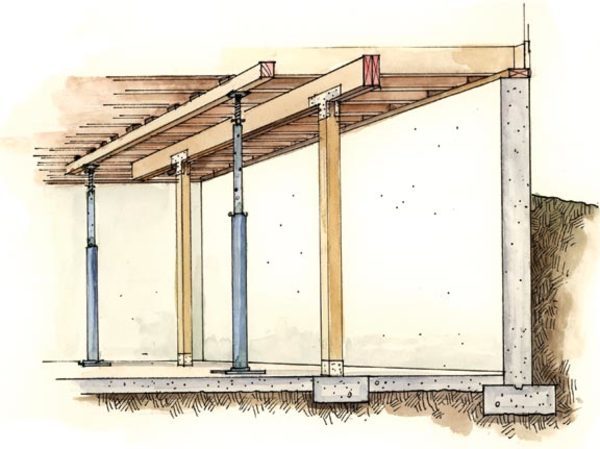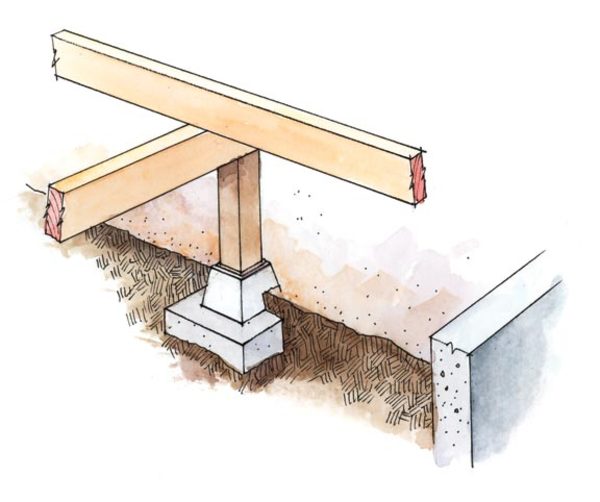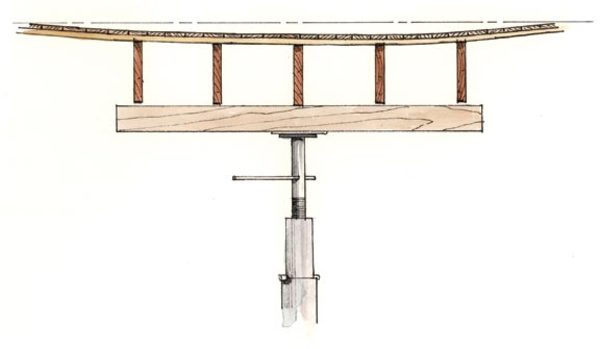One of the most common complaints of old-house owners is sagging floors. In my own house, for example, every floor pitches toward the center stairwell. Although generally only an annoyance, sagging floors can be an indication of worsening problems. Here’s a quick review of the most common problems and a few of the typical remedies.
Depending upon the conditions, it is possible to strengthen or repair existing framing members, such as floor joists or roof rafters, by adding reinforcing material. Rob Leanna
What Causes Sagging Floors in Older Homes
Typically, floors settle near the center of the house because the perimeter walls are constructed over a sound, deep foundation and settle very little. Major support beams within this perimeter, though, are often supported by makeshift posts.
How to Inspect Your Home When Your Floors are Sloping
- Inspect Support Beams: If your house is built over a basement, first inspect all of the basement support beams and posts where they meet the floor. Be suspicious of wood posts set on dirt floors or wood posts with concrete poured around the post bases. As the posts slowly rot and melt into the floor, the house settles accordingly, bottom to top. As a test, firmly push a metal probe or screwdriver into the post at the floor line. If this area is mushy, punky, or rotten, you may have found your problem.
- Inspect Floor Joists: Also look for floor joists that have been cut improperly to install pipes, wiring, or HVAC ducts.
- Look for Insect Damage and Moisture: If you’ve had a chronically damp basement or crawlspace, look for indications of insect damage to structural members. Powderpost beetles leave joists and beams riddled with small holes, carpenter ants are usually apparent at the first sign of warm weather in the spring, and termites usually leave telltale mud tunnels on foundations and posts. Then solve moisture problems around and under the house and repair deteriorated or compromised structural members.
Support posts should not sit on dirt floors, but instead be upgraded to concrete pads with footings that spread the load. Rob Leanna
Improper holes and notches from alterations and running service lines are a major source of weakened joists. Generally there should never be any cuts or penetrations in the middle third of any joist, or anywhere along the bottom of the joist. Notches at the end of a joist should not exceed 1/4 of the joist depth. Center notches (B) should not exceed 1/6 of the joist depth. Holes should be a minimum of 2″ in from the top or bottom of the joist, and no larger than 1/3 the depth of the joist.
Three Ways to Fix a Sagging or Sloping Floor
- Add Reinforcing Metal: Depending upon the conditions, it is possible to strengthen or repair existing framing members, such as floor joists or roof rafters, by adding reinforcing material. Sandwiching the member on either side with plywood is sometimes worthwhile, but the plywood must be installed correctly for greatest strength.
- Sistering: A better option is sistering, where identical lumber is bolted to the member.
- Sistering with a Flitch Plate: Better still is sistering with a flitch plate, a 1/4″ to 1/2″ piece of steel or plywood. Two flitch plates may also be used to repair localized damage.
Where these repairs are not sufficient, also consider shoring up joists or beams that were cut, drilled, or notched for pipes, wires, or ducts.
Stretch a string across the floor to evaluate the amount of deflection, then use it as a benchmark for improvement when jacking. Rob Leanna
One of the good things about floor deflection is that it is repairable. The bad news is that it often takes a long time. The solution to sagging floors, or the damaged sills and joist ends that contribute to them, often involves jacking. A common scenario is to install temporary jack posts and support beams, then permanent posts and beams over new footings. A taut string stretched across the floor will show the amount of deflection and improvement. Posts set on dirt floors should be upgraded to concrete pads with footings. Place wood posts on metal post supports to create a waterproof barrier between the post and the footing.
Jacking must proceed slowly; it took a long time for your floor to sink, so you can’t push it back up quickly without causing cracks and stress in the building. As with other structural repairs, jacking must also be done appropriately. You cannot simply put a screw jack under the lowest spot and start turning. Ideally, someone with experience will assess the problem and set up the posts and any necessary beams. You can then screw the jacks up a turn or two each month. Expect some cracked plaster along the way, and aim not for perfection, but simply stability and improvement. After all, if perfectly level floors and pristine walls were important to us, we wouldn’t live in old houses, would we?
You may want to contact a structural engineer before doing any work as a precaution.







